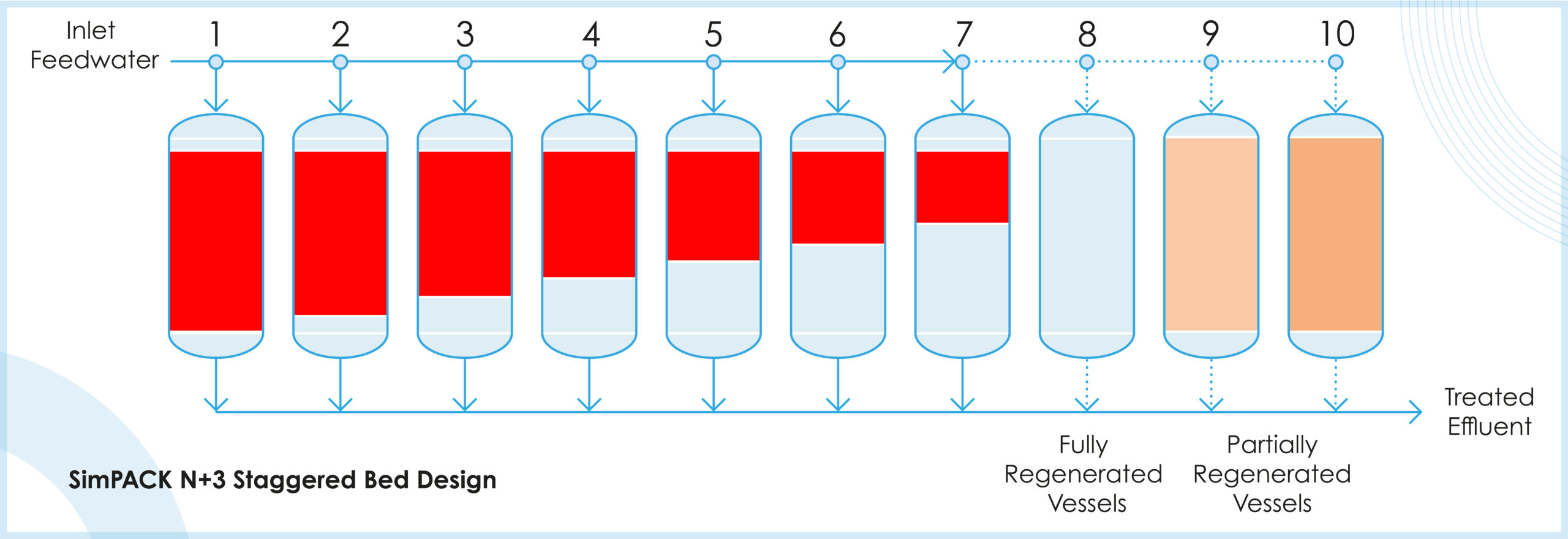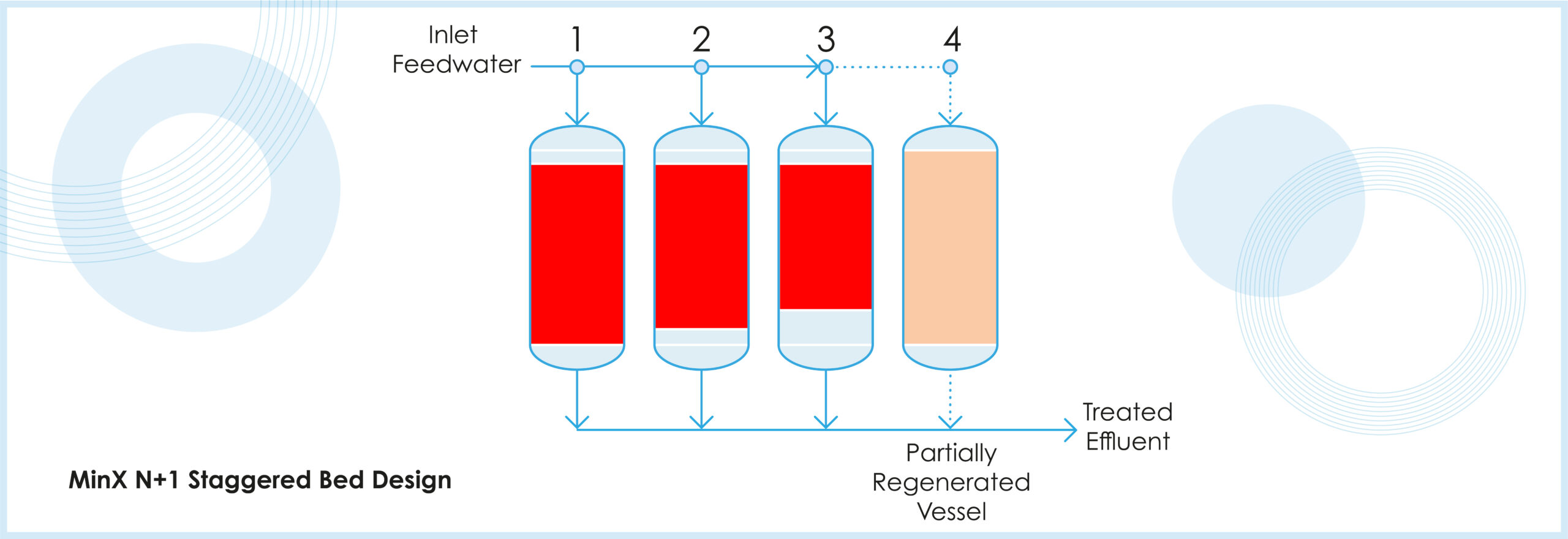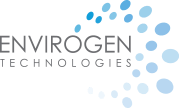Ion Exchange Systems
Ion exchange systems (IX) are water treatment processes that remove unwanted compounds from water or solvents. It works by exploiting the stronger attraction some ions or other contaminants have for a resin within the system compared to staying in the water.
At a basic level, the ion exchange regeneration process:
- Ion capture: As water passes through the system, targeted ions are attracted to and held by the resin, effectively removing them from the water.
- Resin capacity: Over time, the resin becomes “exhausted” after it reaches its capacity to hold any more ions.
- Resin types: IX systems can use either single-use/single-pass resin, which must be replaced, or regenerable resin, which can be cleaned and reused.
- Ion Exchange regeneration process: For regenerable resins, the regeneration involves washing the resin with a regenerant solution (usually a salt, acid, or base). This process clears the resin of contaminants and prepares it for reuse – detailed information provided further down the page.
Envirogen’s regenerable ion exchange systems span various flowrates:
These solutions are outlined in the next sections.
Additionally, we offer a single-pass IX solution, CleanPoint, with a flow rate of 10-500 gpm, alongside a range of industrial water softener systems, including EcoSoft (2-100 gpm) and EcoSave (40-225 gpm). We also provide off-site IX resin regeneration services and equipment, including:
- Wastewater service deionization (WWSDI)
- Portable exchange deionization (PEDI)
Regenerable Ion Exchange Systems
Regenerable IX systems utilize IX resins to remove target contaminants or combinations of contaminants from water and wastewater. What sets these systems apart from traditional non-regenerable or single pass systems is their ability to restore the ion exchange capacity of the resins through regeneration with a concentrated ion solution. This difference makes regenerable ion exchange systems more cost-effective and environmentally friendly over the long term, as they reduce waste and the need for continual replacement of materials.
Regenerable IX systems are widely used in scenarios where large volumes of water need continuous treatment, such as in municipal water supply, industrial processing, and wastewater treatment facilities, offering a sustainable on-site solution to manage resource efficiency.
Markets and applications:
| Markets | Contaminants – Inorganics | Contaminants – Organics |
|
|
|
To address diverse and specific environmental management needs, a holistic approach is essential when implementing regenerable IX systems. Key considerations include varying water treatment volumes, start-up and shut-down operations, protection from environmental elements, ensuring quiet operation, security, and safe delivery and handling of materials in and out of the site. This approach enables tailored solutions to be developed to meet a range of requirements.
Advantages of Regenerable Ion Exchange Technology
Envirogen’s regenerable ion exchange systems (SimPACK and MinX) have been acknowledged for over two decades as a proven, cost-effective solutions for water treatment. Offering efficient and simple operation, these systems effectively remove various anionic contaminants such as hexavalent chromium, perchlorate, and nitrate, making them suitable for addressing complex treatment issues with a unified technology approach.
Innovative multi-bed system configuration:
- Automated sequencing: systems are sequenced in and out of service automatically using our proven process control software, ensuring very low waste rates.
- Flexible volume requirements: capable of meeting a wide range of volume requirements.
- Remote water monitoring communication system: Envirogen IX systems feature advanced remote monitoring, enabling real-time oversight and proactive management.
Envirogen regenerable IX system designs offer:
- More available bed volumes for treatment than traditional IX, at a lower operating cost.
- Modular prefabricated designs delivered for quick, easy installation and start-up.
- In many locations, the cost of contaminant removal is significantly influenced by consumables and waste handling. To address this, high-efficiency, multi-bed designs are employed. These aim to match waste rates with available disposal options while minimizing inputs of regenerant and waste products.
- Redundancy and control system capabilities that provide the data system set-point optimization needed to ensure quality effluent goals are continuously met while minimizing operating costs.
- Sensing, data logging, and remote communication capabilities to enable operators to review and attend the unit as needed either from a distance or on site.
With option for additional Brine Processing Unit (BPU):
- Minimize potentially hazardous nature of brine streams.
- Reduce overall volume of waste generated even further.
Three regenerable IX treatment options for metals:

Ion exchange water treatment systems: This diagram compares three options for treating metal-contaminated water. Regenerable IX systems are displayed as options 2 and 3, with the third option incorporating an additional brine processing unit (BPU). This addition offers extra operational expenditure savings (OPEX), making it the most economically advantageous and sustainable choice due to its non-hazardous waste brine outputs.
SimPACK (for flow rates 400+ GPM) – Regenerable IX
Envirogen’s patented SimPACK regenerable ion exchange technology is designed to treat contaminated water at flowrates over 400 gallons per minute (gpm). The system utilizes a multi-bed design operated in a staggered mode process, employing specialty resins tailored to specific target contaminants.

Envirogen SimPACK systems
N+3 Staggered Bed Design
The SimPACK system features a total of 10 vessels and operates as follows:
- N+3 Design: Seven vessels are in operation, one is on standby, and two are being regenerated.
- Influent Distribution: Influent flows to beds 1-7, with each bed at different levels of breakthrough (some may be overloaded).
- Combined Effluent: The combined effluent ensures that the effluent from overloaded beds is diluted by the effluent from other beds.
- Cascade Regeneration: This process involves the reuse of water and brine, enhancing efficiency and reducing waste.
The ion exchange regeneration process is meticulously controlled and monitored using a Programmable Logic Controller (PLC), which leverages Envirogen’s SimPACK control logic to minimize waste and reduce salt/brine consumption.

Envirogen SimPACK N+3 staggered bed design
SimPACK ion exchange systems can be designed and installed in a building, or in an engineered shipping container and delivered directly to the site to shelter the system from weather and tampering. Additionally, its compact design and automated operation make it particularly suitable for space-restricted treatment facilities and remote locations.
Click play on the animation to see a fly-by of the containerized version of the SimPACK system, including brine processing unit (BPU), two waste tanks, prefiltration, and ten (10) regenerable IX vessels
MinX (for flow rates 10-400 GPM) – Regenerable IX
Designed to treat contaminated water at flow rates between 10 and 400 gpm, MinX regenerable ion exchange technology incorporates an N+1 multi-bed design operated in a staggered mode process. In this design, “N” represents the number of ion exchange vessels required to be online, ensuring that while active beds are treating water, one vessel is always in standby or undergoing regeneration.
N+1 Staggered Bed Design
- N+1 Design: Three vessels are in operation, one is regenerating or in standby.
- Influent Distribution: Influent flows to beds 1-3, with each bed at different levels of breakthrough (some may be overloaded).
- Combined Effluent: The combined effluent ensures that the effluent from overloaded beds is diluted by the effluent from other beds.
- Cascade Regeneration: This process involves the reuse of water and brine, enhancing efficiency and reducing waste.

Envirogen MinX N+1 staggered bed ion exchange system design
The MinX system can be installed within a building or housed in an engineered shipping container for direct delivery to the site, offering protection from weather and tampering. Its compact and automated design makes it especially suitable for space-restricted treatment facilities and remote locations. Advanced control logic further enhances the system’s efficiency, minimizing waste rates and salt/brine consumption.

An Envirogen MinX regen IX system, delivered as a containerized solution
In addition, we offer a range of standard water softening units, including:
- EcoSoft: Cost-effective industrial water softener systems for reducing water hardness to less than 4ppm with flowrates between 2-100gpm.
- EcoSave: High-efficiency water softening system using counter-current IX technology to deliver salt and water savings with flow rates between 40-225gpm.
Single-Pass Ion Exchange
CleanPoint: Non-regenerable IX option for low flow rates (0-500 gpm).
Envirogen offers the CleanPoint non-regenerable ion exchange system, designed for low- to moderate flow applications. These modular or skidded systems are highly adaptable to specific needs and are ideal for point of entry (PoE) applications, or where low contaminant loading levels are anticipated. Featuring non-regenerable ion exchange media, this media is disposed of after exhaustion, simplifying operations and maintenance. These systems are also fully automated to minimize operator attention required.
Envirogen Life Cyle Cost Assurance Programs
For ongoing peace of mind, our systems are backed by a performance guarantee over the lifetime of the regenerable IX system installation, creating the best opportunity for an optimized life-cycle cost. This manages the risk of non-compliance and allows clients to focus on their core business.
Envirogen has over 20 years of turnkey design, installation, and operations and maintenance (O&M) experience with dewatering and groundwater turn-key remediation projects at more than 100 sites. Our integrated O&M offering includes engineering, process, treatability, and other technical services as important components. This commitment of technical expertise in support of O&M allows us to be flexible to adapt to changing conditions for maximum reliability.
It’s important to note that life-cycle costs are site-specific, highly dependent on flow rate, type of operation, and water chemistry. This context underlines the importance of our flexible approach, allowing us to meet the unique needs of each site and maintain compliance over time.

